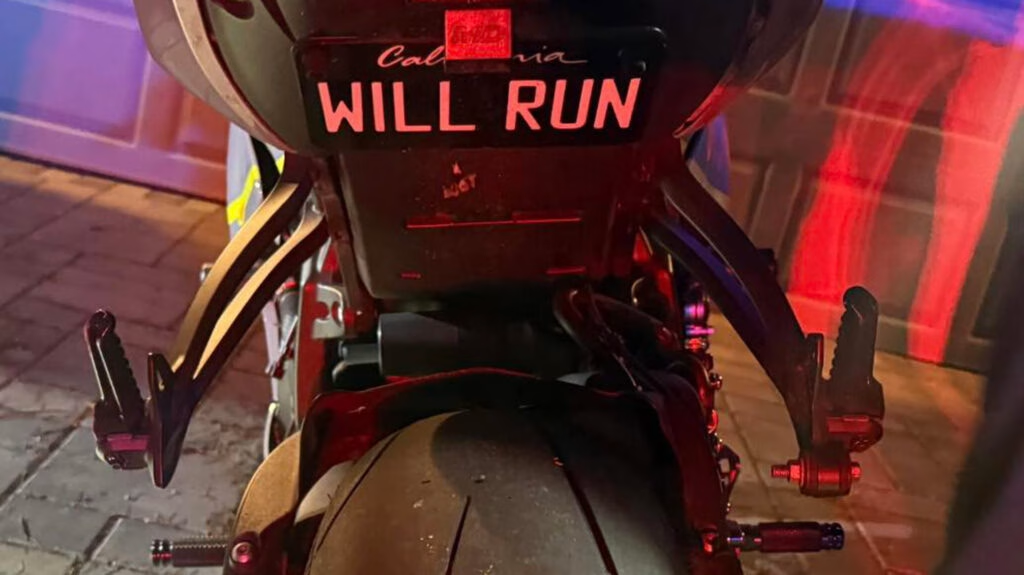How Did Police Safely End a High-Speed Motorcycle Chase in California?
When a Kawasaki Ninja 6R rider in Modesto decided to test his luck against the police, he probably thought his triple-digit speeds and nimble bike would give him the upper hand. After all, motorcycles are notoriously tough to catch—especially when they can weave through traffic and vanish in seconds. But this time, the police had a trick up their sleeve: patience and a helicopter.
What Happened During the Pursuit?
It all started on a Monday night, when officers spotted the rider—whose license plate, ironically, read Will Run. Instead of engaging in a dangerous, high-speed pursuit on the ground, the officers made a calculated decision. They called off the chase, letting the Stanislaus County Sheriff’s Air Support Unit take over from above.
The helicopter quietly tracked the suspect as he zipped through city streets, eventually following him all the way to his home in East Bay. Once the rider thought he was in the clear and parked his bike, ground units moved in and made the arrest. The result? Pure magic. No innocent bystanders hurt, no risky maneuvers, and a suspect in custody.
Why Did Police Back Off Instead of Chasing?
High-speed chases are among the riskiest parts of police work. According to a 2022 FBI report, pursuits result in hundreds of injuries and dozens of fatalities each year—many involving bystanders who had nothing to do with the crime. That’s why law enforcement agencies across the country are rethinking their approach.
In this case, officers recognized that chasing a motorcycle at high speeds through city streets could easily end in disaster. By pulling back and letting the air unit do the heavy lifting, they eliminated the immediate danger to the public. It’s a strategy that’s gaining traction in departments focused on safety and accountability.
Do Most Suspects Give Up When the Pressure’s Off?
Surprisingly, yes. The same FBI study found that most fleeing suspects return to normal driving behavior within minutes after a ground pursuit is called off. Without flashing lights and sirens in their rearview mirror, adrenaline fades and risky behavior drops off. The suspect in this story was no exception—he headed home, thinking he’d gotten away.
This isn’t just theory. Departments in cities like Los Angeles and Seattle have reported fewer crashes and injuries since adopting helicopter tracking and limiting ground chases. The data speaks for itself: smarter tactics save lives.
How Do Air Units Change the Game?
Helicopters give police a bird’s-eye view that’s nearly impossible for suspects to shake. From above, officers can track vehicles through neighborhoods, alleys, and even heavy traffic—without tipping off the suspect. The air unit can relay real-time updates to ground teams, who can then move in safely when the time is right.
Take the Modesto case. The air unit’s footage showed just how closely they could monitor the rider’s every move, even as he tried to blend in or take detours. It’s a level of surveillance that ground units simply can’t match.
What’s the Real-World Impact of These Tactics?
The shift toward helicopter tracking and de-escalation isn’t just about catching bad guys—it’s about protecting everyone else. In 2023, California saw a 15% drop in pursuit-related injuries after several departments adopted these new policies, according to the California Highway Patrol’s annual report. That means fewer trips to the ER for innocent drivers and less property damage for city residents.
There’s also a psychological angle. When suspects realize police aren’t going to play their game, the thrill of the chase disappears. And as this case showed, even the most confident runners—license plate and all—can’t outrun a patient, well-coordinated response.
What Can Other Departments Learn from This?
The Modesto pursuit is a textbook example of how technology and restraint can work hand in hand. Instead of taking the bait and risking lives, officers used every tool at their disposal to bring the situation to a safe close. It’s a lesson in humility, too: sometimes, the smartest move is to wait.
Departments looking to update their pursuit policies should consider investing in air support and training officers to recognize when to step back. It’s not about letting suspects get away—it’s about catching them without collateral damage.
The Big Takeaway
Chasing down suspects isn’t about bravado or high-octane drama. It’s about making smarter choices that put public safety first. The next time you see a wild chase on the news, remember: the best outcomes often come from patience, teamwork, and a willingness to adapt. Start with one change this week, and you’ll likely spot the difference by month’s end.

